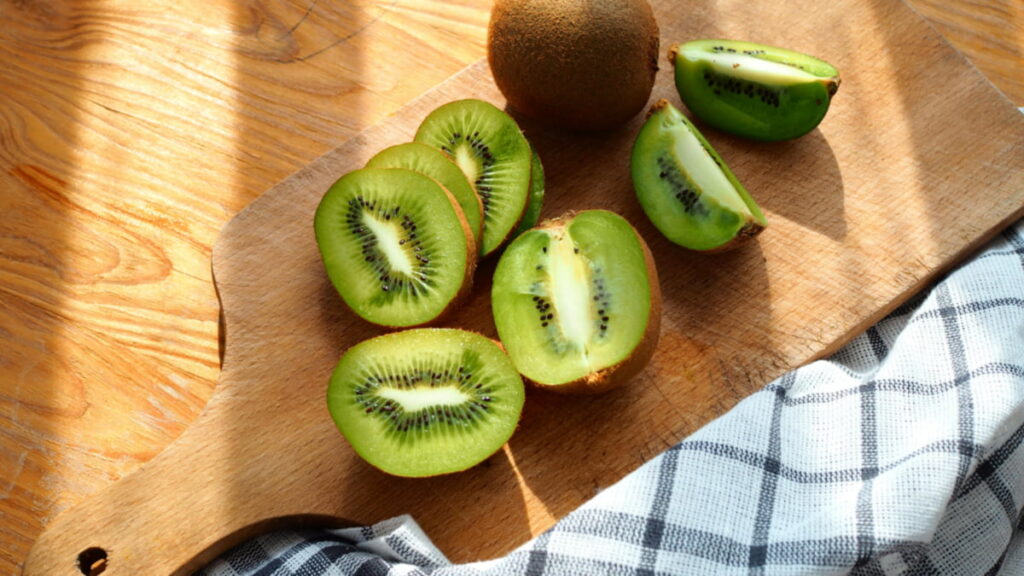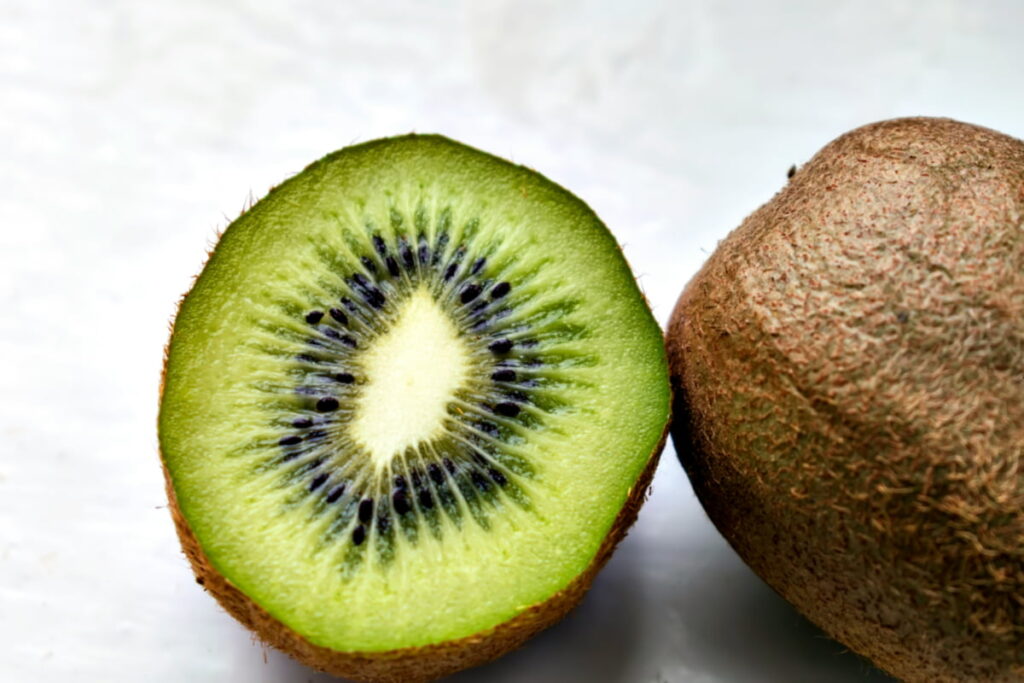
I’ve bought kiwis in every possible state, rock hard, perfectly ripe, and more than a few that stayed like baseballs no matter how long they sat on the counter.
For years, I couldn’t figure out why some softened beautifully while others never got past sour and firm. It turns out, kiwis follow their own quiet chemistry, and once you understand how temperature and ethylene really work, you can guide them to ripeness instead of guessing.
Here’s how to get sweet, tender kiwis every time, no shortcuts required.
Quick Guide: How to Ripen Kiwis Naturally (and Quickly)

| Method | Timeframe | What to Do |
| Counter Ripening | 3–7 days | Leave kiwis at room temperature, away from direct sunlight. Check daily; when they give slightly to pressure, they’re ready. |
| Paper Bag Trick | 1–3 days | Place kiwis in a brown paper bag with an apple, banana, or orange. Fold loosely to trap ethylene gas and speed up ripening. |
| Refrigerate Ripe Kiwis | Up to 7 days | Once softened, move them to the fridge to slow ripening and preserve flavor. Do not chill firm fruit—it halts the process. |
Tip: Room temperature and a little patience give the best flavor and texture. Once ripe, store them cool to hold that perfect stage.
The Science: Why Kiwis Ripen the Way They Do

I used to think kiwis were unpredictable, some softened overnight, others never budged. Once I learned what was actually happening inside the fruit, it became a lot easier to get them right. Like avocados and bananas, kiwis are climacteric, which means they continue to ripen after they’re picked.
The key is a gaseous compound called ethylene, a natural plant hormone that tells the fruit to soften, sweeten, and develop flavor.
Inside each kiwi, enzymes slowly turn starch into sugar and soften the cell walls, creating that sweet scent and tender texture without turning the fruit mushy.
Temperature is what decides how fast that chemistry happens:
- Ideal: around 65–75°F (18–24°C), steady warmth keeps those enzymes working smoothly.
- Too cold (<50°F / 10°C): the process nearly stops, leaving hard, starchy fruit.
- Too hot (>85°F / 29°C): enzymes shut down early, so the kiwi softens before it ever tastes ripe.
Once you understand that, ripening kiwis stops feeling like guesswork. It’s just about giving the fruit the right conditions and letting nature finish what it started.
How to Ripen Kiwis the Right Way

Once you understand how kiwis ripen, getting them soft and sweet becomes simple. Whether you’ve got a few days or need them ready by tomorrow, these methods work without shortcuts or gimmicks.
1. Ripen at Room Temperature (Best Flavor)
If you’re not in a rush, this is the method that truly delivers. It takes patience, but it produces the best texture, the richest flavor, and that faintly floral aroma you only get from natural ripening.
Let kiwis sit undisturbed on the counter, no bags, no heat, no fridge. The slow pace gives enzymes time to turn starches into sugars evenly, so the fruit softens from the inside out.
How to do it:
- Spread firm kiwis in a single layer, away from sunlight or warm appliances.
- Turn them occasionally so they soften evenly.
- Check once a day; when there’s a gentle, even give near the stem, they’re ready.
- Move ripe fruit to the fridge to hold for a few more days.
Why it works:
Steady warmth keeps the kiwi’s enzymes active, building sweetness gradually and balancing acidity for that clean, honeyed flavor.
2. Paper Bag Method (Faster Ripening)
Sometimes you need results fast, maybe for a recipe or brunch. The paper bag method speeds things up naturally by concentrating the gases fruits release as they ripen.
Place kiwis in a brown paper bag with a ripe banana, apple, or peach. The already-ripe fruit sets the pace, creating a slightly warmer, more active environment inside the bag. If you’ve ever used this trick to ripen bananas or peaches, it’s the same gentle principle.
How to do it:
- Add 2–4 kiwis and one ripe fruit to a brown paper bag.
- Fold the top loosely to keep airflow while holding warmth.
- Check daily; most kiwis soften within 1–3 days.
When they yield gently to pressure, move them to the fridge to hold at peak ripeness.
3. The Rice Method (Traditional Shortcut)
A lesser-known trick, especially common in India for ripening mangoes, also works with kiwis. Dry rice traps the natural gases around the fruit, creating a gentle, enclosed warmth that speeds ripening safely, no heat required.
How to do it:
- Fill a container or bowl with uncooked rice.
- Nestle firm kiwis inside, fully covered but not packed tight.
- Check once or twice a day; they usually ripen within 1–2 days.
It’s fast, clean, and surprisingly effective, just don’t forget them, or they’ll overripen quickly.
4. Refrigerate Only When Ripe
Cold slows ripening, it never starts it. Once your kiwis feel slightly soft and smell fragrant, move them to the fridge to pause the process and hold that sweet, juicy stage.
How to do it:
- Wait until the fruit is ripe, soft with a light aroma.
- Store in a breathable produce bag or vented container for up to a week.
- Avoid sealing tightly in plastic; trapped moisture dulls flavor or causes mold.
Think of refrigeration as holding, not helping. Once the fruit is ready, cool air simply slows the clock so you can enjoy that perfect texture longer.
Once you know what works, it’s easy to think faster is better, but with kiwis, rushing ruins the result. A few common “shortcuts” can stop ripening entirely. Here’s what to avoid.
What Not to Do with Unripe Kiwis

After wasting more kiwis than I’d like to admit, I learned that most of the popular “quick-ripening hacks” don’t actually work. The goal isn’t to make the fruit soft, it’s to let the natural ripening process finish on its own. Heat, cold, and sealed storage all interrupt that chemistry and leave you with texture but no flavor.
- Microwaving: Softens the fruit but destroys the enzymes that create sweetness.
- Oven or towel heat: Too much heat too fast; the outside softens, the inside stays firm.
- Refrigerating when firm: Cold stops ripening completely, hard kiwis stay hard.
- Sealing in plastic: Blocks airflow and traps moisture, leading to mold and off-flavors.
Better instead: Give kiwis warmth, air, and time. Real ripening can’t be rushed, but it rewards your patience every time.
How to Tell When a Kiwi Is Ripe
I’ve probably misjudged kiwis more than any other fruit, cutting them open too early, finding them rock hard, or waiting too long and ending up with something syrupy and grainy. Once I learned what to look for (and what to feel for), it became much easier to catch that short window when they’re perfect.
Here’s what to notice.
| Stage | Feel | Look / Smell |
| Hard | Very firm, no give | Bright skin, grassy scent |
| Ripening | Slight give near stem | Duller skin, faint fruity smell |
| Ripe | Soft but springy | Even color, sweet floral aroma |
| Overripe | Mushy or leaking | Wrinkled, syrupy or fermented scent |
Quick checks:
- Gently press near the stem, soft with slight resistance = ripe.
- Smell the kiwi; if it’s lightly sweet, it’s ready.
- Wrinkled skin or sticky spots mean it’s past its peak.
Once you’ve nailed that feel, soft but not squishy, you’ll never waste another kiwi again.
What’s Worked for You?
Everyone seems to have a different way to ripen fruit, and half the fun is figuring out what actually works in your own kitchen. Have you tried a trick that gets kiwis just right? Or maybe you’ve had a few that never softened, no matter what you did?
Share your experience or questions in the comments below, I read every one and update these guides with your feedback.
And if you’re ready to keep going, explore more in the How to Ripen Fruits Hub for guides on bananas, peaches, mangoes, and more. You’ll learn how each fruit responds to time, warmth, and patience, the same simple science that turns a hard kiwi into something perfectly sweet.
